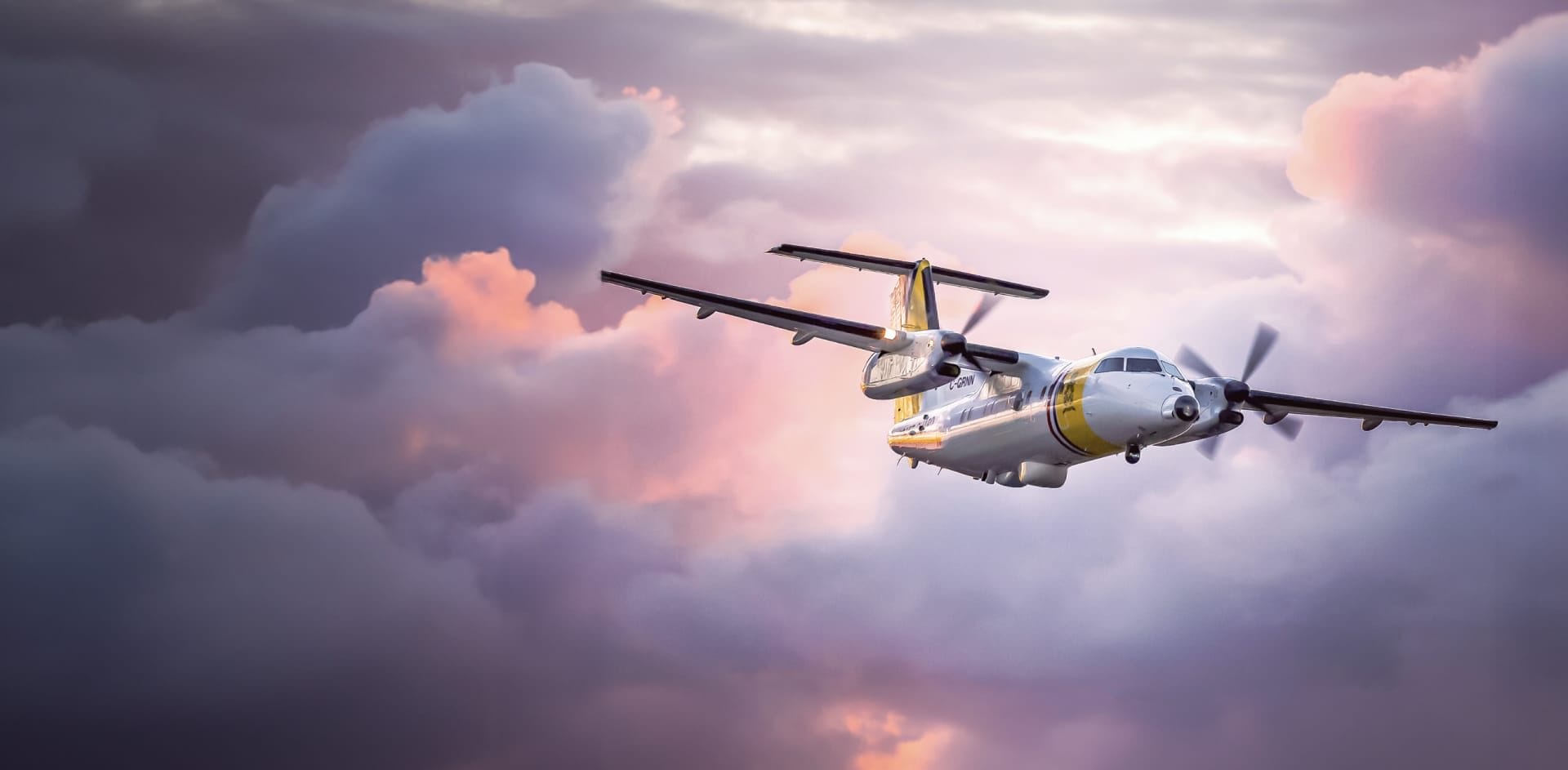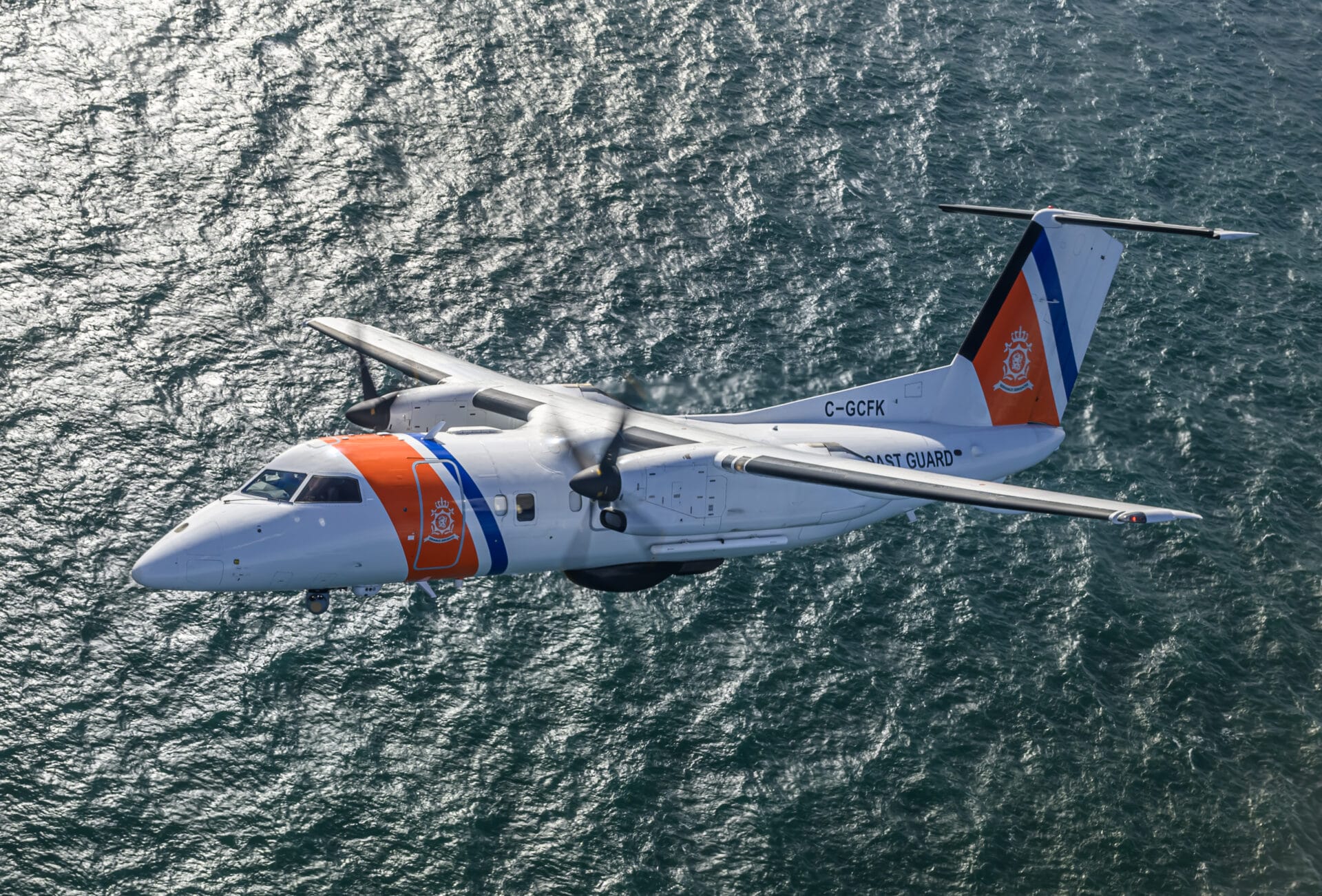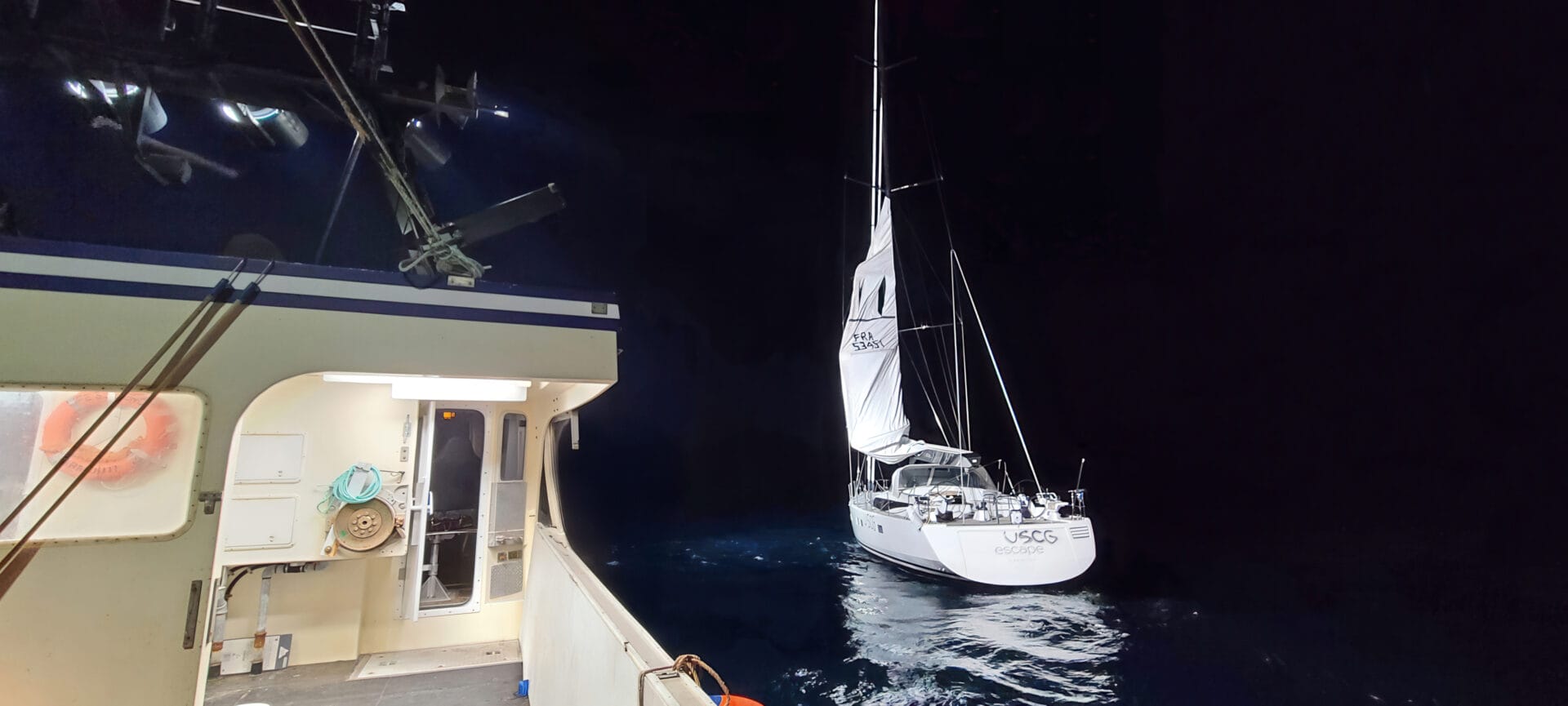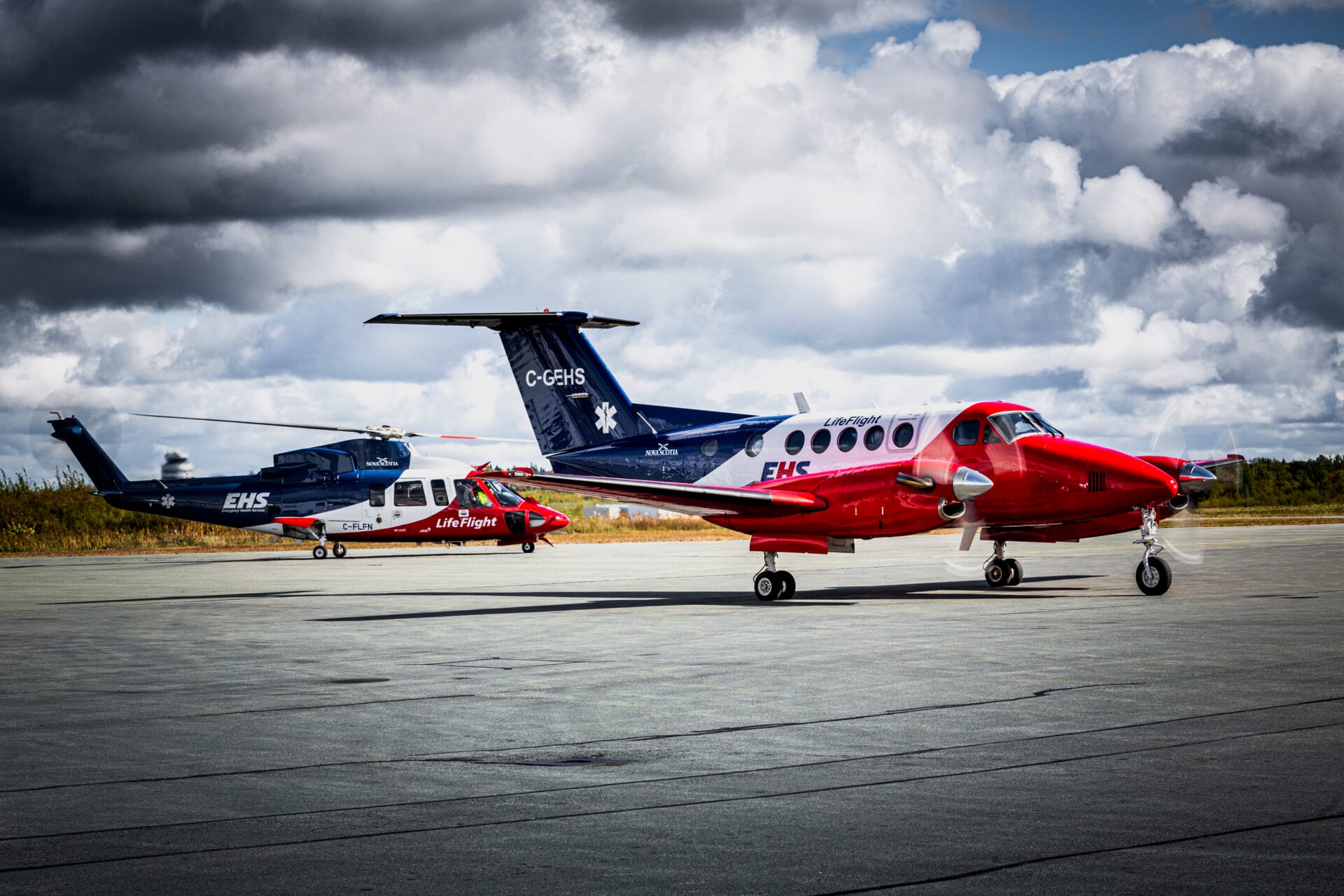How PAL Aerospace helps the Dutch Caribbean Coast Guard make the Southern Caribbean a safer place.
Mission Reliability During 2,650+ Flight Hours
Dispatch Reliability During 2,650+ Flight Hours

Mission Reliability During 2,650+ Flight Hours
Dispatch Reliability During 2,650+ Flight Hours
Aboard the Dash 8, Theo Wilms of the Dutch Caribbean Coast Guard (DCCG), the mission’s sensor operator, studies his maritime search radar’s area scan on a 23-inch display monitor. The scan shows numerous returns from ships on the water’s surface.
Overlaid on Wilm’s radar feed, the aircraft’s mission management system has superimposed numerous symbols flanked by bits of text. The symbols and text indicate the types and estimated locations—based on previous course and speed—of the vessels Wilms had identified during the aircraft’s earlier pass over the area. Many of these symbols lie close to the radar returns Wilms now sees on his screen. Others are farther away. Wilms’s immediate task is to update the recognized maritime picture (RMP) he had plotted during the earlier pass. He’ll do so by correlating the new radar tracks on his display with the vessels he had classified previously.
Wilms clicks on one of the tracks and commands an inverse synthetic aperture radar (ISAR) scan of its position. His display image changes to a grayscale image of a container ship. He sees this is the same cargo vessel he identified an hour earlier, 20 nautical miles to the southwest.
Returning to his RMP display, Wilms can see that the vessel has turned slightly to the north from its previous route, leaving its dead-reckoning-calculated position shadowing it to the southeast. Using his cursor, he clicks and drags its previous track to its new location and commands an update. The system immediately correlates the symbology to the radar track and the vessel’s current course and speed. Wilms repeats this process for several other vessels, rapidly updating his RMP.
Then, he sees it: a small circle indicating a radar paint just a few miles west of Aruba. There are no other symbols nearby.
Wilms selects the track and commands an ISAR scan. The ISAR shows a small, low-profile speedboat lying dead in the water. There is no wake behind it. The image reminds Wilms of a similar craft he had identified many nautical miles to the southwest during his Dash 8’s earlier pass over the area.
Wilms switches back to his moving map display, returning the radar to its area scan mode. He checks the position where he had identified the earlier low-profile. Since that vessel had also been at a dead stop when identified, the display still shows the data he had recorded for that vessel at the same position. Now, however, there is no radar track anywhere in the vicinity.
Meanwhile, as Wilms has been studying his RMP, a small white cross has moved across his display and has come to rest on the selected radar track. The cross indicates the boresight of the Dash 8’s EO/IR imaging system. The mission management system has automatically slewed the turret-mounted EO/IR camera to the selected target. With the press of a button, Wilms switches his display to FLIR (forward-looking infrared) to get a more detailed picture of the vessel. Now, Wilms sees a clear IR image of the ship and its crew. He feels certain this is the same low profile he had observed earlier. The two crew members—one slender, the other stocky and shorter, just as he remembered—appear to be pulling a tarpaulin over their cargo of a dozen or so water-proof plastic barrels in the back of the speedboat.
There is only one likely explanation for such a vessel to be out in these waters carrying cargo at this hour: drug running. Through the mission management system’s integration with the Dash 8’s VHF/UHF radio, Wilms passes the suspect vessel’s coordinates to the DCCG Operations Center in Curaçao to initiate an intercept.
All in a night’s work for the DCCG and their maritime patrol partner, PAL Aerospace.
The Dutch Caribbean Coast Guard (DCCG) is a partnership between the Netherlands and the Caribbean island nations of Aruba, Sint Maarten, and Curaçao. It provides coast guard services for the six islands of the former Netherlands Antilles: the three autonomous constituent countries just mentioned, plus the three Netherlands special municipalities of Bonaire, Sint Eustatius, and Saba.
The duties of the DCCG include narcotics and arms interdiction, border control, customs control at sea, fisheries and environmental surveillance, monitoring of safe shipping, search and rescue (SAR), and disaster relief.
Following their decision to retire their three Lockheed P-3 Orion maritime patrol aircraft due to operational budget constraints, the DCCG put out a tender to contract maritime patrol support from a commercial provider. The contract required the vendor to:
The DCCG awarded this initial ten-year contract to PAL Aerospace of Canada at the end of 2006. Since then, they have been operating two De Havilland Canada DHC-8-106 (Dash 8) turboprop aircraft supplied and maintained by PAL.
Headquartered in St. John’s, Newfoundland and Labrador, PAL Aerospace is an end-to-end aerospace solutions company offering a wide variety of engineering, maintenance, training, and operational support services. To meet the DCCG’s specifications, PAL modified each Dash 8 with additional fuel tanks, an IAI Elta maritime search radar, a FLIR Star SAFIRE III turreted EO/IR sensor, and mission management workstations for the crew’s sensor operator (SO) and tactical coordinator (TACCO).
PAL equipped each Dash 8 for SAR missions with life rafts, smoke markers, and drift marker buoys. The aircraft can also be configured for disaster relief by removing the workstations and installing seats for the transportation of troops, aid workers, and evacuees. There is also ample cargo space for relief supplies.
Baron Smith, Director of Caribbean Operations for PAL Aerospace and one of their Dash 8 captains, said developing a rapport with the DCCG personnel in Curaçao was a challenge at first. “They were military folks accustomed to operating a highly capable military aircraft,” he said. “Their P-3s were large planes capable of anti-submarine warfare. Despite PAL’s track record and our support from the higher ranks—where most believed this was a good move for the Dutch government—many at the ops level were skeptical. They had serious doubts about whether they could accomplish their mission with a converted civilian aircraft, one that would be managed, flown, and maintained by a civilian contractor.”
During the first two years of the contract, PAL and the DCCG experienced some growing pains, as one would expect. Yet, despite some initial doubts, they gradually established a strong working relationship. With a mix of PAL and DCCG crew members manning the two Dash 8s, the DCCG was highly successful in executing a variety of drug interdiction, SAR, and disaster relief missions. Almost immediately, operational readiness was much better than what the DCCG had been accustomed to; it never dropped below the contract requirements of 98% for dispatch reliability and 98.5% for mission reliability.
Eventually, PAL’s flexibility, teamwork, and willingness to go beyond the terms of their contract established a bond of trust between client and contractor.
This flexibility was on full display when Hurricane Irma devastated the Dutch “SSS” islands (Sint Maarten, Sint Eustatius, and Saba) in September 2017. PAL responded by configuring one Dash 8 for disaster relief and dispatching an extra pilot to the Caribbean. The reconfigured aircraft was dedicated to flying Dutch Marines into the SSS islands and evacuating hospital patients and other injured persons to Aruba. The second Dash 8, configured for training support operations, handled all the DCCG’s normal patrol missions while also transporting personnel into and out of the SSS islands.
During its Hurricane Irma relief efforts, PAL logged a tremendous number of flight hours. To complete their mission, they voluntarily exceeded their contracted flight hours for the year.
“We’ve built up a strong relationship between the Coast Guard and PAL,” said Lt. Cmd. Bastian Lankester of the Royal Netherlands Navy (RNLN), the Aviation Staff Officer responsible for all Royal Dutch flying assets and military flying activities in the Caribbean. “We have combined crews, with Coast Guard and PAL people flying on the same aircraft. Over those years, PAL essentially became a member of the Coast Guard. Our people are all one team. PAL adopted our goals; they know what our goals are, and they’re really trying to help us to achieve them.”
By the end of the original support contract’s ten-year term, several new challenges had emerged that would impact the follow-on contract. Some of the equipment PAL had installed a decade earlier was now outdated due to the emergence of new technologies. Also, some of the avionics equipment on board the DCCG’s Dash 8 aircraft was no longer being supported by its suppliers. PAL needed to upgrade some technologies to ensure they could meet their readiness requirements
PAL and the Dutch MOD agreed on a bridge extension contract that extended PAL’s existing maritime patrol service contract for two years. This bridge extension authorized modifications to the two Dash 8 aircraft to replace equipment that either was no longer supported or no longer satisfied regulatory requirements.
Due to Dutch Ministry of Defence (DMOD) procurement rules, requirements for technology upgrades not related to obsolescence would be deferred to the next support contract. That contract would be open to competitive bidding, like the previous ten-year support contract.
The implementation of the bridge extension program consisted of the installation and system integration of the four new components mentioned earlier:
The last of these tasks would be the most demanding. PAL’s subsidiary, CarteNav, would have to customize its AIMS-ISR software to integrate with the new equipment and the rest of the existing system and provide a display symbology set that would fit the DCCG’s needs.
Apart from the technical difficulties of integrating the new avionics, PAL faced two major challenges in meeting their obligations under the bridge contract.
The first was keeping the retrofit and acceptance program on a tight schedule during the COVID-19 pandemic.
The second was maintaining operational readiness with only one aircraft while the other was in Canada for retrofit.
The upgrade was scheduled to begin in November 2020, once the bulk of the hurricane season had passed. To mitigate the risk posed by their reliance on a single aircraft, PAL had a backup plan. In case of a hurricane or problems with the in-service aircraft, an additional Dash 8 aircraft could be immediately dispatched from Canada to assist.
Carrying out the project required much planning and coordination. PAL program management worked closely with its maintenance and forecasting teams and with Lt. Cmd. Lankester and his team. Major maintenance actions like engine overhauls and non-destructive testing were performed early on both aircraft before the first left for modification in Canada. This insured against the grounding of the only available aircraft for maintenance issues.
“According to Baron Smith, Director of Caribbean Operations for PAL Aerospace and one of their Dash 8 pilots, meeting the delivery schedule for the upgrade program “would be a challenge.” While having an additional Dash 8 standing by in Canada provided some comfort, the overall magnitude of the task required careful planning.”
“AIMS needed substantial customization to work for the DCCG. But between the PAL group and CarteNav, we worked closely together to make sure the product we were delivering was a good one. We didn’t want to roll it out the door until we were sure it was good to go.”
COVID-19 restrictions and related supply chain issues had the biggest impact on the schedule.
Lockdowns and travel restrictions made travel within Canada and between Canada and Curaçao difficult. At one point, all commercial airline travel was halted. International entry quarantines meant delays upon arrival.
Workforce issues added to the problem. Personnel contracted COVID and couldn’t work. Stringent workplace safety regulations slowed progress by making it harder to work in teams.
Perhaps the biggest hurdle the team faced was the accumulation of supply-chain issues. Parts that could normally be found on the shelf or obtained within a couple of days suddenly required lead times of eight to ten months, turning normal spares into critical spares. PAL was soon forced to reevaluate and modify its sparing and store capacity. This last move has proved to be prudent, as many of these issues have continued post-COVID.
Overcoming these obstacles required some ingenuity. When commercial airline flights weren’t available, PAL chartered private jets to ferry maintenance personnel between locations. PAL personnel from Curaçao worked flight tests in St. John’s while quarantined in a hotel. To cover part shortages, PAL pulled spares from other divisions within the company and even hand-carried parts to avoid the shipping tie-ups that were occurring at the time.
“One of the nice things about PAL is that we have so many resources to pull from,” said Baron Smith. “We had divisions helping out other divisions to keep things rolling.”
“There were challenges, but PAL was always open and straight in their communications with us,” said Lt. Cmd. Lankester. “When problems arose, they kept us informed. We always knew what was coming. Of course, there were delays, but in the end, they had no impact on operations. That was what was most important for us; there was never a stop in our operations.”
With only one fully-equipped aircraft available in Curaçao, there was a lot of pressure on PAL to maintain operational readiness.
“With one aircraft in Canada, we were aware of the increased risk to serviceability; overall, there was zero impact on operations. That was really impressive, it’s a true testament to the strength of our Curacao team,” said Smith. “We always had to have at least one mission-capable aircraft.” Still, PAL proved up to the test. They worked closely with the DCCG to ensure mission reliability and on-time dispatch reliability while flying more hours than they ever had before—some 2,650 hours with a single aircraft.
Operational readiness remained high. “It was probably our best,” said Smith. “We were 99.8% on mission reliability and 99.7% on dispatch reliability, which is amazing considering we were flying 250 hours above our contract requirement.”
“For more than two years, we had only one aircraft at Curaçao instead of two, but we got almost 100% availability and serviceability from the aircraft and the crew,” said Lankester. “That’s quite an achievement.”
“Most importantly, Baron always let me know when challenges were coming up. Whether it was maintenance scheduling or some other conflict, we were always straight and open with each other and looking for solutions together. I think that’s the main reason why we are getting those high-reliability percentages.”
Integration of TCAS 7.2 and ADS-B Out kept the two DCCG patrol aircraft in compliance with ICAO airspace requirements. TCAS II and ADS-B are currently being adopted throughout the Caribbean, so the DCCG needed to be compliant.
With PAL’s original system using ADAM, operators had to switch between moving map, radar, and FLIR on their main display; each fed the monitor through a separate input. Now, with the radar and FLIR inputs fed through AIMS-ISR, operators see the radar or FLIR image overlaid with geographical features, geopolitical boundaries, waypoints, and other moving map references that can help them interpret the sensor image.
For example, both operators now see overlays of geopolitical boundaries. So, either operator can help the pilot steer clear of other countries’ territorial waters, allowing the pilot to focus primarily on flight safety. Everyone in the cabin is better aware of where they are and of the situation outside the aircraft, both in the air and on the water.
“Before, it was almost up to the TACCO to keep us out of those areas,” said Duane MacLeod, PAL’s Director of Training and head sensor operator in Curaçao. “I can do that on the radar now because I have all those overlays on my radar display. It cuts down the workload for the TACCO, and I get the bigger picture.”
Also, AIMS-ISR’s modular display windows make the system more flexible. “With ADAM, everything was locked in place,” said MacLeod. “With AIMS, the operators can move windows around and customize how their information is laid out. It lets us adapt to different mission profiles.”
Having everything the operator needs all on one screen at the same time makes training new operators much easier, said MacLeod. Operators find the new system more intuitive. In fact, MacLeod was surprised by how fast operators picked up the system operation. “AIMS-ISR is a game-changer for training,” he said. “The training was really helpful,” said Theo Wilms, the DCCG SO. “It’s really easy to understand how it works. It’s very intuitive.”
Wilms praised MacLeod for making the training run smoothly even though CarteNav was still customizing AIMS based on DCCG feedback. “I have to give credit to Duane (MacLeod) because of all he had to deal with,” Wilms said. “One day, he would explain how the symbology worked a certain way. The next day, he would get a software update from CarteNav with some changes we had requested, and it would work differently. But that was all helpful. A big, big Bravo Zulu (well done).
The integration of AIMS-ISR with the new digital radar processor allows the system to filter radar contacts on the ocean surface much more successfully and efficiently. DCCG’s SOs are seeing many more plots on their displays than they had before.
“AIMS is giving us radar plots right away,” said Wilms. “Each of those round symbols is a trigger for the SO: go to that contact and ISAR it. As a result, we find a lot more low-profile radar contacts—possible fast movers. With Adam, we would typically find two or three of those a month. Now, with AIMS, we find three or four low-profiles every week. We seized 37,000 kilos of drugs last year.”
The performance of PAL and CarteNav during the bridge extension upgrade and the enhanced mission capabilities AIMS-ISR provided all had a significant positive impact on PAL’s relationship with the Dutch DMO.
“We promised them something fresh and new, and CarteNav delivered that with AIMS,” said Baron Smith. “The DMO was very excited about the capabilities of AIMS—not just the way it is now, but the things we were talking about doing in the future under the new contract.”
Shortly after the second Dash 8 flew to Canada for its bridge extension modifications, the Dutch MOD awarded PAL Aerospace their second ten-year contract to provide maritime patrol support to the DCCG. This contract extends PAL’s partnership with DCCG until at least 2034.
The new contract not only provides for ten years of aircraft lease and maintenance along with aircrew support. It also includes significant modifications to the Dash 8s. Driven by DCCG requirements, these upgrades will greatly enhance the capabilities of the two aircraft.
The ongoing modifications include:
PAL is now working on these modifications using the same plan they used for the bridge program. One Dash 8 will remain on duty in Curaçao while the other is in Canada for retrofit. As before, a third aircraft is on standby in Canada should a need arise for disaster relief.
Throughout the program, PAL Aerospace has continued to meet its dispatch reliability and mission reliability requirements while supporting an increased number of flight hours. In 2022, they flew over 2700 hours with a single aircraft.
“In fact, we’ve actually increased our tempo of flying by almost 20%,” said Baron Smith. “This year, we’re on track to fly 3,000 hours, which is quite incredible with only one aircraft.”
The DCCG and their PAL crew mates are looking forward to the new capabilities this latest upgrade will provide.
The advanced EO/IR imaging capabilities of the WESCAM MX-15 will give the DCCG a significant boost in surveillance capability. The new sensor’s long-range standoff capability will allow crews to identify and observe smugglers without being detected. Using the latest sensors will put the DCCG on the same playing field as its most advanced partners in the region, including the United States Twelfth Air Force (AFSOUTH) and Southern Command (USSOUTHCOM).
Sentient Vision Systems’ ViDAR, billed by its manufacturer as the World’s First Optical Radar, is a maritime wide-area optical search system able to detect very small objects in the water during both daylight and nighttime operations. PAL had previously integrated ViDAR in aircraft for the Canadian DFO and the Netherlands Coast Guard.
The DCCG spends a lot of time looking for small objects adrift in the vastness of the Caribbean. These include sailors, fishermen, and cruise ship passengers who have fallen overboard, divers separated from their boats, and narcotics cargos thrown overboard by smugglers. People in the water without good survival gear are extremely difficult to find.Small drug boats are also a challenge to locate. Often covered with a blue tarp during the day, they blend in with the surrounding ocean background; they’re very hard to see, even when the radar picks them up.
The new sensors aboard will drastically improve the small target detection capabilities of the DCCG’s aircraft. “Between ViDAR and our new EO/IR, those are going to be game changers for us,” said Baron Smith. New LOS and beyond-LOS sensor and communication capabilities, combined with the advanced sensors, “will be huge for counter-narcotics and intelligence surveillance work,” he added.
Upgrades to the Dash 8s’ SATCOM technology will unlock the full potential of the AIMS-ISR mission management system. These state-of-the-art SATCOM capabilities will help provide next-generation ISR capabilities, including the capacity to download real-time data to operations centers. What’s more, the new tablet computers will allow the pilot and copilot to see the same information that AIMS-ISR provides to the SO and TACCO.
Meanwhile, ADS-B In and Warship AIS will enhance the identification capabilities of the two aircraft. ADS-B In represents an upgrade over TCAS and keeps the Dash 8s up-to-date with industry norms. Integration with AIMS-ISR will enhance the DCCG’s ability to track the positions of other aircraft in the area.
Warship AIS is similar to standard AIS (Automatic Identification System) but with some additional capabilities. It allows the crew to shut off the identification transmission to prevent identification of the aircraft by unfriendly aircraft or vessels. It also allows the crew to spoof unfriendlies by providing false location information—showing the aircraft in a place where it is not—while still being able to see other friendly assets in the area.
Finally, the Dash 8s are being fitted to deploy iridium self-locating drift marker buoys (ISL DMB), which the DCCG will use instead of conventional DMBs going forward. Equipped with an Iridium® bi-directional satellite transmitter, sea surface temperature sensor, and a GPS receiver, ISL DMBs are designed to communicate critical location and temperature data in real-time. They represent a significant enhancement to the DCCG’s SAR capabilities.
“We’re looking forward to our new sensor suite,” said Lankester. “Our current FLIR is ten years old, and the technology keeps evolving. So, we’re happy our aircraft are being updated to the current state of the art. The upgrade of the mission management system will give us more opportunities for improvement as well.”
“We’re very pleased to be partnering with PAL Aerospace for another ten years,” said Lankester, who pointed out that the latest contract is off to an auspicious start. “Last year, because of the good work they’ve done, we increased the number of flight hours in the contract by 600, and we achieved that total.”
Lankester also praised PAL Aerospace and its personnel for being great team players and making the DCCG’s objectives their top priority. “The DCCG’s motto is Samen Sterk: Together Strong,” he said. “I think our motto sums up very well our relationship with PAL. We don’t see each other as a customer on one side and a supplier on the other. I see one crew operating as one unit to achieve common goals. That’s very nice to see.”


